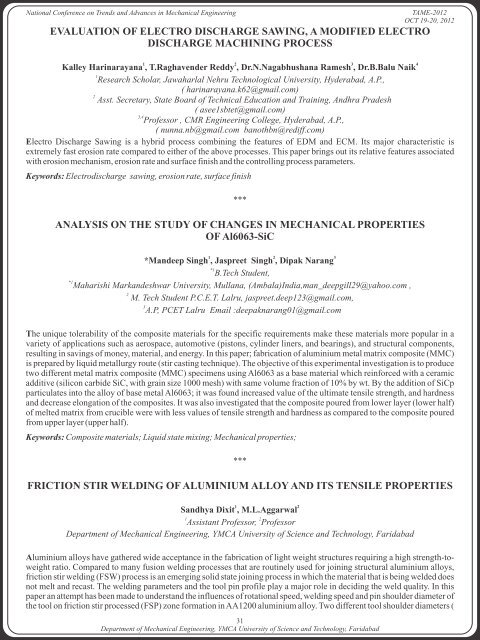Souvenir Containing Abstracts - YMCA University of Science ...
Souvenir Containing Abstracts - YMCA University of Science ...
Souvenir Containing Abstracts - YMCA University of Science ...
You also want an ePaper? Increase the reach of your titles
YUMPU automatically turns print PDFs into web optimized ePapers that Google loves.
National Conference on Trends and Advances in Mechanical Engineering<br />
EVALUATION OF ELECTRO DISCHARGE SAWING, A MODIFIED ELECTRO<br />
DISCHARGE MACHINING PROCESS<br />
1 2 3 4<br />
Kalley Harinarayana , T.Raghavender Reddy , Dr.N.Nagabhushana Ramesh , Dr.B.Balu Naik<br />
1<br />
Research Scholar, Jawaharlal Nehru Technological <strong>University</strong>, Hyderabad, A.P.,<br />
( harinarayana.k62@gmail.com)<br />
2<br />
Asst. Secretary, State Board <strong>of</strong> Technical Education and Training, Andhra Pradesh<br />
( asee1sbtet@gmail.com)<br />
3,4<br />
Pr<strong>of</strong>essor , CMR Engineering College, Hyderabad, A.P.,<br />
( nunna.nb@gmail.com banothbn@rediff.com)<br />
Electro Discharge Sawing is a hybrid process combining the features <strong>of</strong> EDM and ECM. Its major characteristic is<br />
extremely fast erosion rate compared to either <strong>of</strong> the above processes. This paper brings out its relative features associated<br />
with erosion mechanism, erosion rate and surface finish and the controlling process parameters.<br />
Keywords: Electrodischarge sawing, erosion rate, surface finish<br />
***<br />
ANALYSIS ON THE STUDY OF CHANGES IN MECHANICAL PROPERTIES<br />
OF Al6063-SiC<br />
1 2 3<br />
*Mandeep Singh , Jaspreet Singh , Dipak Narang<br />
*1<br />
B.Tech Student,<br />
*1<br />
Maharishi Markandeshwar <strong>University</strong>, Mullana, (Ambala)India,man_deepgill29@yahoo.com ,<br />
2<br />
M. Tech Student P.C.E.T. Lalru, jaspreet.deep123@gmail.com,<br />
3<br />
A.P, PCET Lalru Email :deepaknarang01@gmail.com<br />
TAME-2012<br />
OCT 19-20, 2012<br />
The unique tolerability <strong>of</strong> the composite materials for the specific requirements make these materials more popular in a<br />
variety <strong>of</strong> applications such as aerospace, automotive (pistons, cylinder liners, and bearings), and structural components,<br />
resulting in savings <strong>of</strong> money, material, and energy. In this paper; fabrication <strong>of</strong> aluminium metal matrix composite (MMC)<br />
is prepared by liquid metallurgy route (stir casting technique). The objective <strong>of</strong> this experimental investigation is to produce<br />
two different metal matrix composite (MMC) specimens using Al6063 as a base material which reinforced with a ceramic<br />
additive (silicon carbide SiC, with grain size 1000 mesh) with same volume fraction <strong>of</strong> 10% by wt. By the addition <strong>of</strong> SiCp<br />
particulates into the alloy <strong>of</strong> base metal Al6063; it was found increased value <strong>of</strong> the ultimate tensile strength, and hardness<br />
and decrease elongation <strong>of</strong> the composites. It was also investigated that the composite poured from lower layer (lower half)<br />
<strong>of</strong> melted matrix from crucible were with less values <strong>of</strong> tensile strength and hardness as compared to the composite poured<br />
from upper layer (upper half).<br />
Keywords: Composite materials; Liquid state mixing; Mechanical properties;<br />
***<br />
FRICTION STIR WELDING OF ALUMINIUM ALLOY AND ITS TENSILE PROPERTIES<br />
1 2<br />
Sandhya Dixit , M.L.Aggarwal<br />
1 2<br />
Assistant Pr<strong>of</strong>essor, Pr<strong>of</strong>essor<br />
Department <strong>of</strong> Mechanical Engineering, <strong>YMCA</strong> <strong>University</strong> <strong>of</strong> <strong>Science</strong> and Technology, Faridabad<br />
Aluminium alloys have gathered wide acceptance in the fabrication <strong>of</strong> light weight structures requiring a high strength-toweight<br />
ratio. Compared to many fusion welding processes that are routinely used for joining structural aluminium alloys,<br />
friction stir welding (FSW) process is an emerging solid state joining process in which the material that is being welded does<br />
not melt and recast. The welding parameters and the tool pin pr<strong>of</strong>ile play a major role in deciding the weld quality. In this<br />
paper an attempt has been made to understand the influences <strong>of</strong> rotational speed, welding speed and pin shoulder diameter <strong>of</strong><br />
the tool on friction stir processed (FSP) zone formation in AA1200 aluminium alloy. Two different tool shoulder diameters (<br />
31<br />
Department <strong>of</strong> Mechanical Engineering, <strong>YMCA</strong> <strong>University</strong> <strong>of</strong> <strong>Science</strong> and Technology, Faridabad













